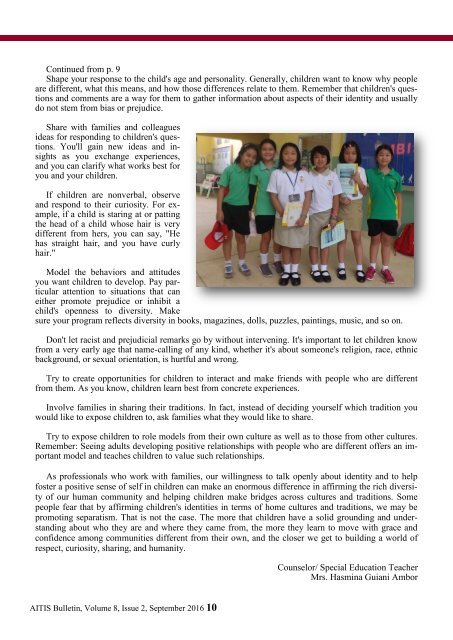AITIS Bulletin, Volume 8, Issue 2, September 2016
Create successful ePaper yourself
Turn your PDF publications into a flip-book with our unique Google optimized e-Paper software.
Continued from p. 9<br />
Shape your response to the child's age and personality. Generally, children want to know why people<br />
are different, what this means, and how those differences relate to them. Remember that children's questions<br />
and comments are a way for them to gather information about aspects of their identity and usually<br />
do not stem from bias or prejudice.<br />
Share with families and colleagues<br />
ideas for responding to children's questions.<br />
You'll gain new ideas and insights<br />
as you exchange experiences,<br />
and you can clarify what works best for<br />
you and your children.<br />
If children are nonverbal, observe<br />
and respond to their curiosity. For example,<br />
if a child is staring at or patting<br />
the head of a child whose hair is very<br />
different from hers, you can say, "He<br />
has straight hair, and you have curly<br />
hair."<br />
Model the behaviors and attitudes<br />
you want children to develop. Pay particular<br />
attention to situations that can<br />
either promote prejudice or inhibit a<br />
child's openness to diversity. Make<br />
sure your program reflects diversity in books, magazines, dolls, puzzles, paintings, music, and so on.<br />
Don't let racist and prejudicial remarks go by without intervening. It's important to let children know<br />
from a very early age that name-calling of any kind, whether it's about someone's religion, race, ethnic<br />
background, or sexual orientation, is hurtful and wrong.<br />
Try to create opportunities for children to interact and make friends with people who are different<br />
from them. As you know, children learn best from concrete experiences.<br />
Involve families in sharing their traditions. In fact, instead of deciding yourself which tradition you<br />
would like to expose children to, ask families what they would like to share.<br />
Try to expose children to role models from their own culture as well as to those from other cultures.<br />
Remember: Seeing adults developing positive relationships with people who are different offers an important<br />
model and teaches children to value such relationships.<br />
As professionals who work with families, our willingness to talk openly about identity and to help<br />
foster a positive sense of self in children can make an enormous difference in affirming the rich diversity<br />
of our human community and helping children make bridges across cultures and traditions. Some<br />
people fear that by affirming children's identities in terms of home cultures and traditions, we may be<br />
promoting separatism. That is not the case. The more that children have a solid grounding and understanding<br />
about who they are and where they came from, the more they learn to move with grace and<br />
confidence among communities different from their own, and the closer we get to building a world of<br />
respect, curiosity, sharing, and humanity.<br />
Counselor/ Special Education Teacher<br />
Mrs. Hasmina Guiani Ambor<br />
<strong>AITIS</strong> <strong>Bulletin</strong>, <strong>Volume</strong> 8, <strong>Issue</strong> 2, <strong>September</strong> <strong>2016</strong> 10


